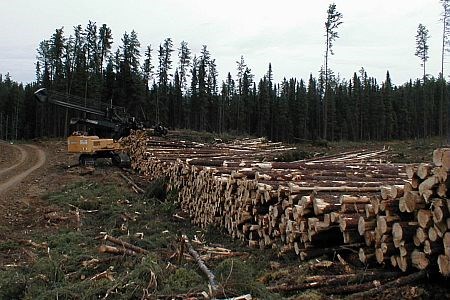The battle over forestry tenure has long raged through Northern Ontario, but rarely has it become more heated than in 2009 as government, municipalities and private industry struggle to create real change.
The issue of cutting rights came to a head this year as the province began to move on altering how those rights are allocated, with public consultation sessions having wrapped in the fall.
However, the province’s restriction of logging activity in Algonquin Park has given the Ontario Forest Industry Association (OFIA) no confidence in its ability to handle changes to the tenure system.
Referring to the early November move as “David Copperfield politics,” OFIA president Jamie Lim disputes the government’s claim of a balanced approach.
Instead, this and the potentially restrictive Far North Act shows the province acting upon predetermined outcomes, rather than truly listening to outside concerns, she says, creating great doubt about the tenure process.
“All I want to know in the first paragraph of that tenure reform policy is a guarantee of a minimum of 24 million cubic metres of industrial fibre for the province of Ontario going forward,” says Lim.
“If they want to remove large tracts of land, as long as you’re replacing it with large tracts from somewhere else so we can get the industrial wood fibre, fine. But guarantee it, whether we’re using it today or not...as that’s future economic opportunity for all of us in this province.”
Currently, the province provides cutting rights through sustainable forest licenses (SFL), which are granted for 20 years and are reviewed after every five. When mills close, however, the wood allotment remains in the hands of the company.
Governmental response has been for interested parties to strike deals with the SFL holder, an approach which has often left many unable to secure a wood allotment.
Some, such as Timmins’ recently expanded Little John Enterprises, have found ways to thrive regardless; others, such as the faltering Smooth Rock Falls, have not.
Over the last six years, Ontario has seen 35 permanent mill closures with 9,000 lost jobs, as well as 27 indefinite mill closures threatening 5,500 jobs. This translates to 14,500 direct jobs, and 43,500 indirect jobs being affected by the downturn.
These numbers are truly “staggering,” according to Scott Jackson, the OFIA’s policy director, and this figure will continue to grow, particularly as the Algonquin decision will put another 195 out of work.
“Let’s face it, anything we want to do, whether it’s the primary forest industry or the value-added forest industry, they all have one thing in common: you need wood,” says Lim. “And yet they’re out there, talking about biomass and this and that, but we have to ask, with what?”
Others, like Laurentian University economist David Robinson, argue that sustainability is largely only possible through proper planning and tenure policies that encourage growth. This includes local access to resources as well as locally produced power, low-cost infrastructure and facilities that can cheaply be converted to new uses.
“Our tenure policy actually ensures the collapse of communities,” says Robinson. “We need leaders with an understanding of economic and social development.”
Michael Gravelle, Minister of Northern Development, Mines and Forestry, says the importance of tenure reform is something not lost on him, especially as several forest communities in his riding of Thunder Bay-Superior North are struggling.
While he says he understands the pressing nature of the need to change the system, the system will require a balance to be struck between local value-added opportunities and the larger firms who have provided economic benefits to those communities.
The system as it sits is in need of additional flexibility to accommodate a wide variety of interests, with more room to take factors such as mill closures or municipal interests into account.
“We’re very committed to effecting change,” says Gravelle.
“But it’s going to be challenging to make the changes. There will be some tough decisions we’ll have to make.”
The province is mulling over the results of the public consultation period, though no defined timeframe has been presented for announcing any subsequent steps, except says Gravelle. It will likely coincide with the second phase of calls for interest in biomass-related allocation.
www.ofia.com
www.mndm.gov.on.ca
www.mnr.gov.on.ca




